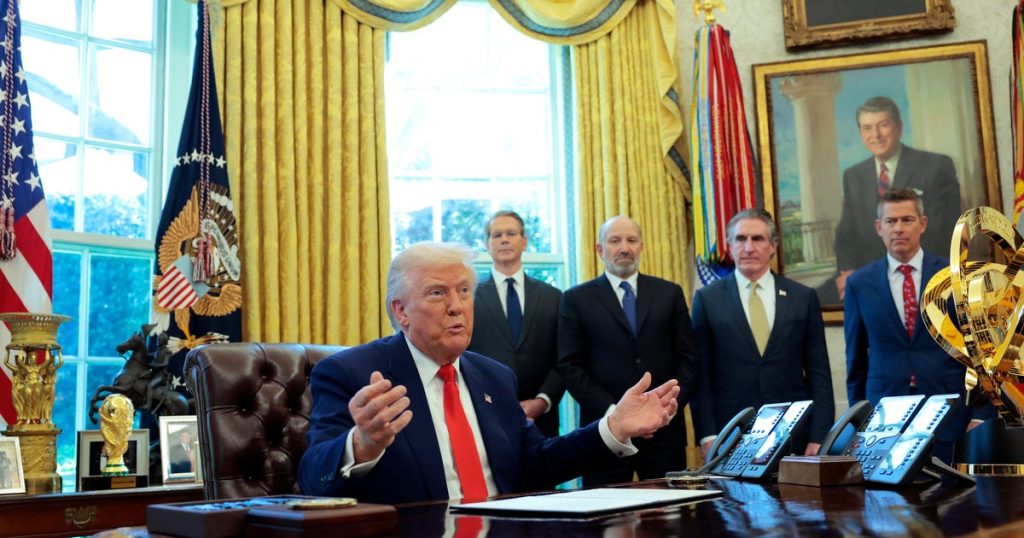In recent discussions, senior advisers surrounding President Trump expressed concerns regarding the potential fallout from proposed tariffs on the economy. Despite efforts to project a unified front in support of these tariffs, internal disagreements have emerged, highlighting significant fears about their implications for global financial stability. Sources reveal a contentious debate between key administration officials over the necessity and potential consequences of implementing robust tariffs.
| Article Subheadings |
|---|
| 1) Internal Conflicts Within the Administration |
| 2) Divergent Opinions on Tariff Impact |
| 3) Financial Markets Respond |
| 4) Presidential Intervention and Market Reactions |
| 5) The Path Ahead for U.S. Tariff Policy |
Internal Conflicts Within the Administration
As discussions around tariffs heated up leading into April 2, when these measures were publicly announced, notable divisions became apparent among President Trump’s advisers. Internal conversations revealed worries about the potential adverse effects of such tariffs on global financial markets and the U.S. economy. Treasury Secretary Scott Bessent and White House trade adviser Peter Navarro had a particularly heated discussion regarding the proposed implementation of tariffs. Inside chief of staff Susie Wiles‘ office, Bessent cautioned against extreme measures, predicting turmoil in financial markets should the tariffs be enacted as envisioned by Navarro.
Divergent Opinions on Tariff Impact
The debate on tariffs has seen significant back-and-forth among influential figures within the administration. Notably, Navarro’s stance was clear: advocacy for a broad application of 25% tariffs on imported goods valued at $3 trillion. In contrast, Bessent raised substantial concerns over the risks of implementing such widespread tariffs, fearing devastating impacts on market stability. The clash reportedly drew on previous experiences with former administration members who had advised against aggressive tariff strategies, further evidenced by Navarro’s pointed remarks which implied that current advisers should not repeat the mistakes of their predecessors.
Financial Markets Respond
In the days following the announcement of tariffs, the financial markets reacted vigorously, validating apprehensions shared by advisers about impending economic instability. As predicted, trillions of dollars were wiped off major stock indexes, sending shockwaves throughout the bond markets. Analysts from financial firms such as Goldman Sachs raised the possibility of a recession, and corporate leaders voiced increasing unease. For instance, JPMorgan Chase CEO Jamie Dimon remarked in an interview that a recession was “a likely outcome,” and Delta Airlines CEO Ed Bastian described the situation as “self-inflicted turmoil,” emphasizing the unprecedented uncertainty surrounding the economic environment.
Presidential Intervention and Market Reactions
Under growing pressure from financial experts and CEO feedback, President Trump took action to mitigate the fallout from the recent tariff announcements. Following a series of alarming market developments, he opted to pause some tariffs for 90 days, a move intended to relieve tension and stabilize investor sentiments. Trump’s directive came as he sought to address the perceptions of panic among market players, acknowledging their apprehensions and urging a more cautious approach to the trade policies that were set in motion.
The Path Ahead for U.S. Tariff Policy
As the situation evolves, concerns remain about the future of U.S. tariff policies and their broader implications on both domestic and international economic landscapes. The ongoing internal debates within the administration reflect deeper uncertainties about the effectiveness of the proposed tariffs. With input from various administration officials and evidence from financial market reactions, it is clear that the administration faces a complex balancing act. The potential for economic repercussions looms large, and how the White House navigates these turbulent waters will likely define the trajectory of U.S. trade policies in the coming months and years.
| No. | Key Points |
|---|---|
| 1 | Internal disagreements within the Trump administration have raised concerns over proposed tariffs. |
| 2 | High-ranking officials warn of potential economic instability due to widespread tariffs. |
| 3 | Financial markets have reacted negatively, with trillions lost following tariff announcements. |
| 4 | President Trump paused some tariffs to alleviate market fears. |
| 5 | The future of U.S. tariff policy remains uncertain amid internal and external pressures. |
Summary
The discussions surrounding President Trump’s proposed tariffs reveal significant internal dissent and fears of broader economic impact. As market responses reflect the apprehensions of advisers and corporate leaders, the administration is faced with the challenge of reassessing its approach to trade policy to prevent potential economic fallout. Moving forward, the ability of the administration to navigate these complexities will play a crucial role in shaping the future of economic policy in the U.S.
Frequently Asked Questions
Question: What are the proposed tariffs intended to address?
The proposed tariffs are aimed at adjusting trade balances and encouraging domestic production by levying fees on imported goods.
Question: How have financial markets responded to the announcement of the tariffs?
Financial markets reacted negatively, with significant losses in major stock indexes and increased concerns about the possibility of recession.
Question: What steps did President Trump take following the market turmoil?
President Trump paused some of the tariffs for 90 days to mitigate market fears and stabilize investor confidence.


